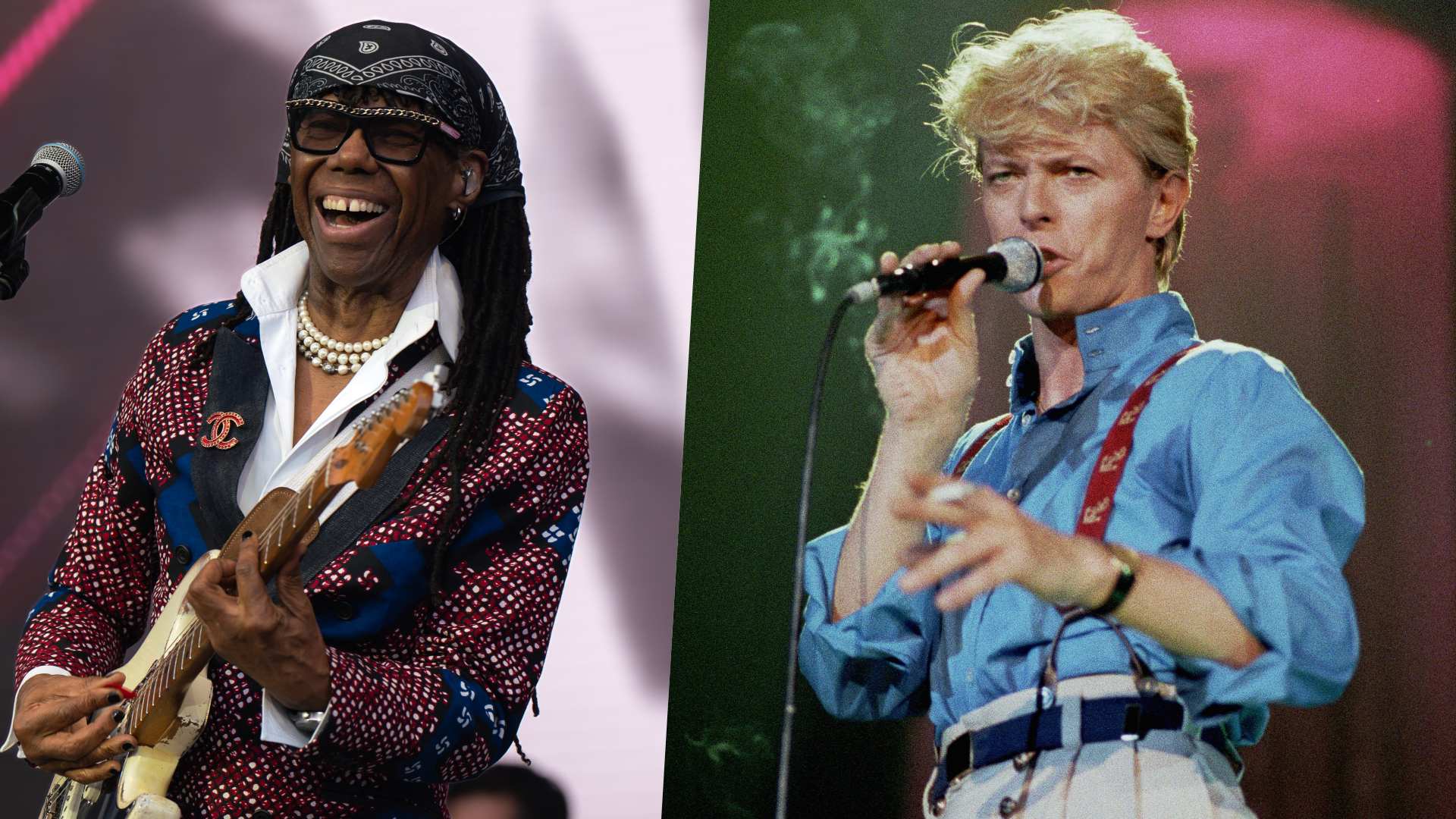“Bowie strolled into my bedroom with a guitar. ’Hey, Nile, listen to this, I think it could be a hit…”: Does Nile Rodgers deserve more credit for Bowie’s 1983 classic?
"A strummy folk guitar part with a moving voice in the chords? It didn’t even sound close to what I’d call a hit”

Chic star, legendary guitarist and music producer Nile Rodgers has guest-curated a display for the new, soon-to-be-opened David Bowie Centre, in London.
The new installation has been put together by London's V&A Museum within their new East Storehouse in the Queen Elizabeth Olympic Park, in Stratford, London, and features correspondence between the two stars and a bespoke Peter Hall suit, hand picked by Rodgers, which was worn by Bowie during his Serious Moonlight tour.
The David Bowie Centre opens on September 13.
And with Rodgers back in the Bowie frame, fans can once more debate the degree of Rodgers' input into the album that propelled him into second-wave '80’s superstardom and its title track that would prove to be Bowie’s biggest hit – Let’s Dance.
Over the years, it’s safe to say that Rodgers has been keen to convey the fact that Let’s Dance was an altogether different animal prior to him getting his hands on it.
"That is my most rewarding production to date,” Rodgers told Guitar Techniques back in 2007. “Even though it clearly sounds like David Bowie - his voice is so distinctive - when you hear the tracks and the guitars, it sounds like a Nile Rodgers recording in the tradition of Chic and Sister Sledge.
"The truth is, I could not have done something like Let's Dance without David. With Chic, no radio station would have played it but with David, the music was genius.”
Want all the hottest music and gear news, reviews, deals, features and more, direct to your inbox? Sign up here.
Certainly, the track bears all the hallmarks of a Chic recording and Rodgers' own inimitable guitar work is all over it, but surely the song was a fully formed Bowie composition before the producer got to work?
Not so, according to Rodgers, who insists that the early demos of potential Let’s Dance tracks were so bad that he thought that Bowie was pranking him.
"When David came to me with the songs he believed they could be hits. When I first heard them I thought he was crazy. This was a guy who I had idolised all my life.
"I loved Ziggy Stardust, Young Americans and Heroes but I thought he was being mean and cruel to me, putting me to a test.
"I thought he wanted me to act like every other jerk in the music business and go, 'Sure David, I think these songs are great'. At best they were okay but not what I consider hits.
"I called at least three friends that knew David and asked if he was playing a trick on me. They seemed to think he was serious.”
"I want you to make hits”
Writing in his 2011 autobiography Le Freak, Rodgers describes how Bowie pursued him following a chance meeting in a nightclub, hiring the producer with: “I’d like you to do what you do best – I want you to make hits”.
The instruction took Rodgers by surprise as he’d just completed an experimental new album and had hoped to avoid being “ordered back to the hit-making plantation”. However, by his own admission, his latest work hadn’t exactly turned out as he intended.
“I knew it was a flop right away,” he admits. “I’d been so afraid of being labeled a disco musician that I was too tentative about the album’s direction. And the songs weren’t hooky enough. During the recording, the cocaine reassured me that the record was cool. The problem was, I’d started to believe the coke.”
But with both he and Bowie out of contract and without a label, Bowie was to prove the perfect partner in getting Rodgers back on track. “A new liberator had entered my life. Bowie’s history, innovation, artistic brilliance and white-English-rocker status bestowed upon me a freedom that was almost unimaginable,” Rodgers gushes.
But first they’d need some songs…
After arriving as a guest at Bowie’s Swiss chalet in Lausanne on the banks of Lake Geneva, it didn’t take long before Bowie showed Rodgers what he had up his sleeve – namely the title track that would become the lead from their future smash hit album.
“Bowie strolled into my bedroom with a guitar. 'Hey, Nile, listen to this, I think it could be a hit,'” writes Rodgers. “He started strumming a twelve-string acoustic that had only six strings. What followed was a folksy sketch of a composition with a solid melody.
"The only problem was it sounded to me like Donovan-meets-Anthony-Newly. And I don’t mean that as a compliment.
“It wasn’t bad by artistic standards but I’d been mandated to make hits, and could only hear what was missing.
“We’d spent a fair amount of time together in New York… We’d listened to tons of records… We looked at scores of album covers, press photos and artwork and talked about what we considered ‘cool’. And then this?
"A strummy folk guitar part with a moving voice in the chords? It didn’t even sound close to what I’d call a hit… I scribbled down the chords and said I’d take a crack at an arrangement.”
Rodgers' arrangement banished the strumming and dubious tuning, replacing them with “staccato stabs and strict harmonic interpretation” and the pair, alongside a hastily put-together band of local musicians recorded a demo at Mountain Studios in Montreux (owned by Queen).
“This recording was the first indication of what we could do together as I took his ‘folk song’ and arranged it into something that the entire world would soon be dancing to and seemingly has not stopped dancing to for the last 35 years! It became the blueprint not only for ‘Let’s Dance’ the song but for the entire album as well,” Rodgers said of the demo.
Certainly it’s clear to see Rodgers' influence already reshaping the song with Tony Thompson-style Chic stop-starts and, of course, his own guitar work. Soon after the session Bowie and a band of pros set up in New York’s Power Station studio with “my favourite engineer” Bob Clearmountain at the controls.
Interestingly the sessions excluded both Bernard Edwards and Tony Thompson, Rodgers' famous Chic partners as they were “so unreliable from drugging I was afraid they'd be late for a recording session,” he explains. “I decided they were too risky.”
Instead Rodgers called in superstar drummer Omar Hakim and bassist Carmine Rojas to ably fill their shoes, with Rodgers taking the lead, reminding them that “they were working for me, not Bowie. After his ass goes home, motherf__kers, I’ll still be here,” Rodgers intoned.
"The song was going to be a major hit and we all knew it"
And what better song to start the sessions with than Let’s Dance. “We cut the song in one or two takes and it set the tone for the rest of the project. The song was going to be a major hit and we all knew it. David relaxed into my team’s capable, wickedly creative, loving hands.
“The moment we finished off that [intro] trumpet solo I knew we were in new territory and could play by different rules.
"We attacked David’s music like an invading army. It was a siege. After years of being denied entry through the front door of rock and roll we had our battering rams posed to knock down the walls… I finally brought in Tony Thompson who struck the drums so hard that the sound pressure levels dimmed the studio lights with each backbeat. It was like, 'Yeah, motherf__kers, take that!,'” Rodgers writes.
However, it was entirely Bowie’s idea to bring in a “then unknown guitarist from Texas” to play on the record – Stevie Ray Vaughn.
“David had seen Stevie play at the Montreux Jazz festival and knew that he wanted to work with him. If you want an example of David’s artistic genius, this is it. He saw newbie Stevie Ray play live once and that was enough to convince him.”
Though it’s clear that Rodgers was determined to get the credit that he felt he deserved. “In just over two weeks I’d reconstructed and rearranged every single song [on the album] and written all the sweetening charts (horns, backing vocals and other overdubs). On top of that Bob and I even changed the keyboards on one track without telling David,” he writes. However that credit was – Rodgers reckons – not forthcoming.
Credit where credit's due
“Everything was perfect except for David‘s reluctance to give me the same props he’d bestowed on his previous producers. He seemed almost embarrassed by the mega-success of Let’s Dance, even though he’d insisted on “making hits”. It was such a strange turn for me because we’d been so close during the production… I was hurt by how little I was mentioned in his media coverage and how he tended to prefer discussing his earlier work whenever he was interviewed. Remember, I was working off six consecutive flops and needed the praise and recognition to help rebuild my career.”
Fortunately, Bowie did go some way to make recompense, speaking years after the success of the album at a charity function for the ARChive of Contemporary Music. “This goes out to Nile Rodgers,” Bowie told the assembled throng. “The only man who could make me start a song with a chorus,” in reference to Rodgers' re-working of his strummed Let’s Dance original.
“That shout-out made my night. I don’t think anybody in the audience had a clue what the hell he was talking about, but I knew and that’s all that counted.” Rodgers writes. “Case closed. I love and respect you, David. Thanks.”
Daniel Griffiths is a veteran journalist who has worked on some of the biggest entertainment, tech and home brands in the world. He's interviewed countless big names, and covered countless new releases in the fields of music, videogames, movies, tech, gadgets, home improvement, self build, interiors and garden design. He’s the ex-Editor of Future Music and ex-Group Editor-in-Chief of Electronic Musician, Guitarist, Guitar World, Computer Music and more. He renovates property and writes for MusicRadar.com.
You must confirm your public display name before commenting
Please logout and then login again, you will then be prompted to enter your display name.
![David Bowie - Let's Dance, Demo (Radio Edit) [Official Audio] - YouTube](https://img.youtube.com/vi/dFAgk61HiyI/maxresdefault.jpg)
